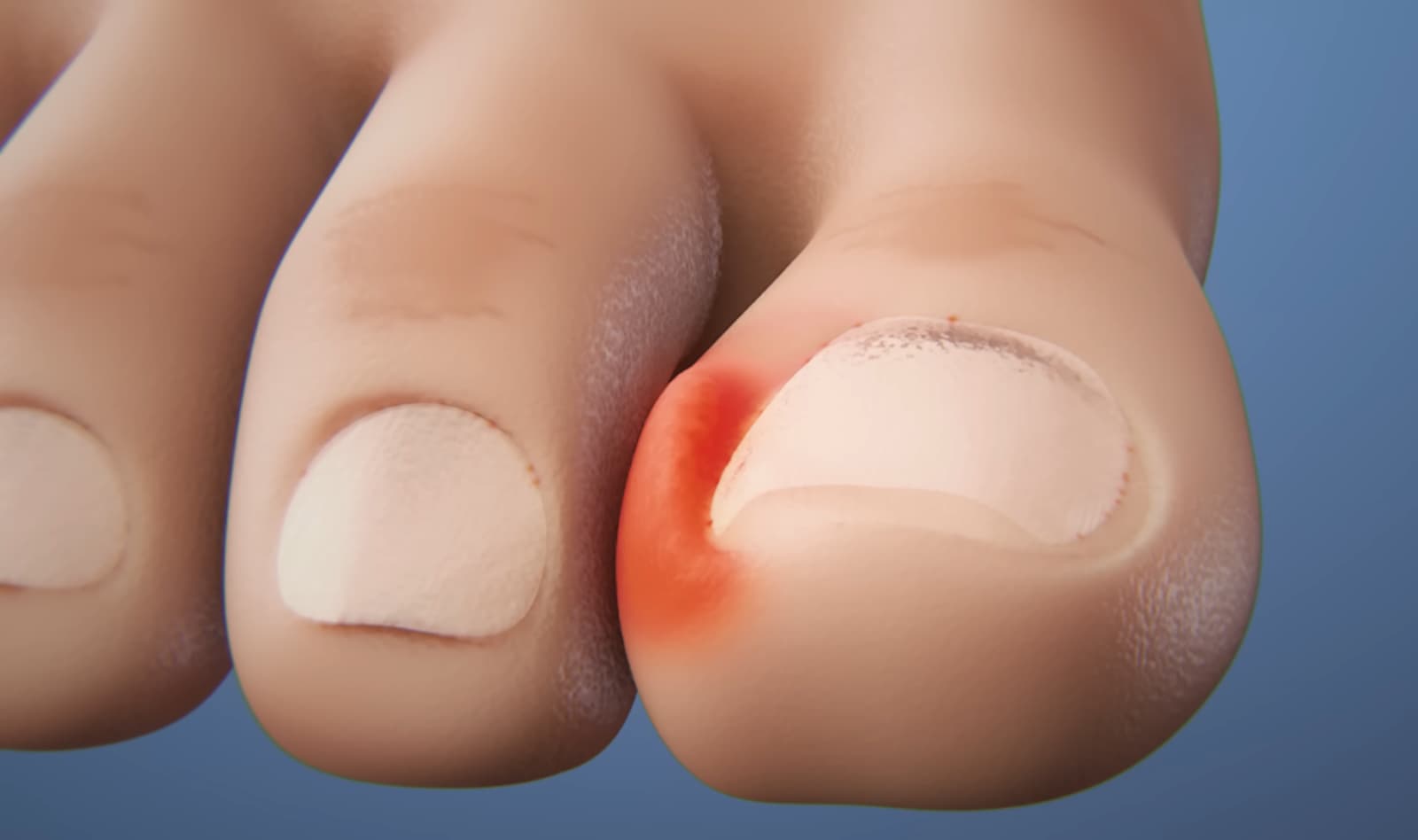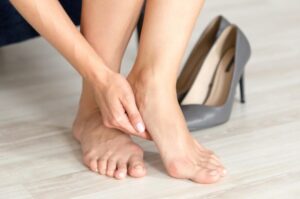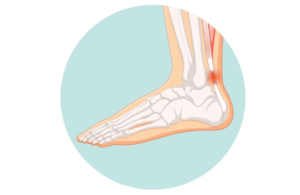What Exactly Is an Ingrown Toenail? A Closer Look
Ingrown toenails, also known as onychocryptosis, are a widespread issue affecting individuals across various age groups. This condition can significantly disrupt daily activities, including sports, education, and professional commitments, thereby adversely affecting one’s overall well-being.
The development of an ingrown toenail occurs when part of the nail begins to grow into the surrounding skin or at the nail’s base. This abnormal growth leads to tissue damage and inflammation, causing discomfort and pain. Moreover, the damage inflicted by the nail can serve as an entry point for bacteria, raising the risk of infection. An infection in the affected area can rapidly escalate the level of pain experienced.
If you’re navigating the discomfort and potential complications associated with an ingrown toenail, you may also like exploring insights into addressing other podiatric concerns, such as a lump on the Achilles tendon, underscoring the interconnected nature of foot health and its impact on overall well-being.
Ingrown Toenails: Exploring Causes and Risk Factors
The development of ingrown toenails can be influenced by various factors beyond just the shape of your nails. These factors encompass everything from your nail-cutting technique to the type of shoes you wear and even your foot hygiene practices.
Your toenails originate from the nail matrix, nestled beneath the skin of your toes. The size and shape of this matrix can vary, resulting in nails that are flat or curved, wide or narrow—each person’s nails are unique.
Individuals with curved or wide toenails are more predisposed to experiencing ingrown nails. This occurs when the nail grows into the surrounding skin edges. However, numerous other causes contribute to this condition:
- Improper nail cutting techniques;
- Habitual nail picking;
- Wearing tight-fitting footwear, particularly high heels, pointed-toe shoes, and certain sports shoes like football or soccer boots;
- Abnormal nail shape, characterized by excessive curvature;
- Experiencing sweaty feet;
- Maintaining poor foot hygiene;
- Presence of bunions;
- Irregular foot movement patterns;
- Trauma inflicted on the nail;
- Fungal infections of the toenails.
Rarely, the presence of bone spurs beneath the nail can also contribute to ingrown toenails.
Understanding these causes and risk factors can help individuals take preventive measures to avoid the discomfort and potential complications associated with ingrown toenails.
Symptoms
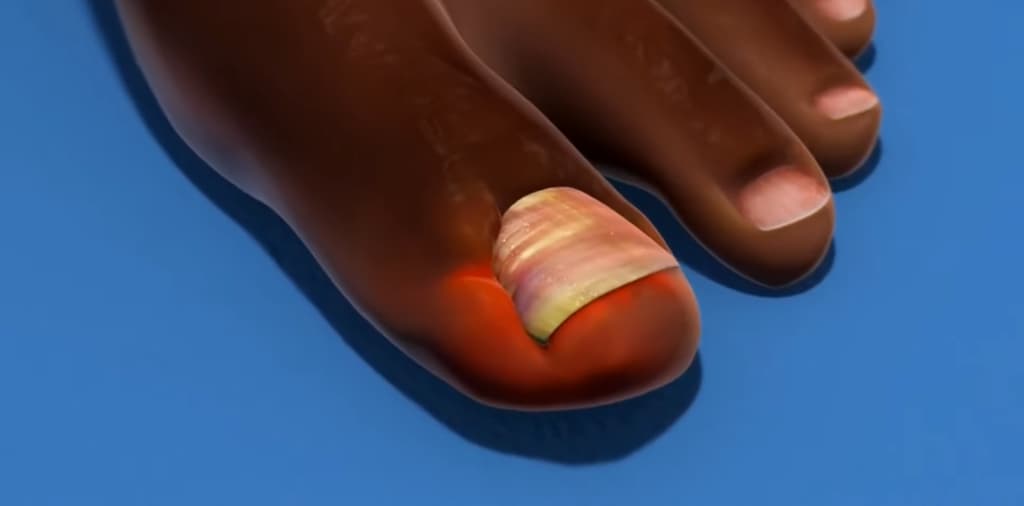
While ingrown toenails commonly manifest as localized pain along the edge or at the end of the toe, they can also present a range of other symptoms indicative of their presence.
In addition to discomfort, watch out for these potential signs of ingrown toenails:
- Heat, Swelling, and Tenderness: The affected area may feel hot to the touch, appear swollen, and be tender to pressure;
- Redness and Infection: As the condition progresses, the area may become increasingly red and prone to infection, accompanied by heightened pain;
- Increased Pain with Pressure: Pain often intensifies when wearing shoes or even when the affected toe is touched, making it sore to the touch;
- Pus and Hypergranulation Tissue: In severe cases, there may be drainage of pus and the development of hypergranulation tissue around the ingrown nail;
- Yellowing of the Nail: Particularly in cases of severe ingrown toenails, the affected nail may take on a yellowish hue.
Although these symptoms strongly suggest an ingrown toenail, it’s essential to obtain an accurate diagnosis. Similar symptoms can also be attributed to conditions such as involuted nails, subungual corns, or simply thickened nails. Incorrect treatment could lead to further damage, infections, and heightened discomfort.
Seeking professional diagnosis and appropriate treatment is crucial to alleviate symptoms and prevent complications associated with ingrown toenails.
Ingrown Toenails: Prevention & Treatment
Essential Advice for Ingrown Toenail Care
If you notice your ingrown toenail showing any signs of infection, such as warmth, redness, discharge or pus, pain and tenderness, or if you’re feeling feverish or unwell, it’s crucial to seek immediate medical attention from a GP or a podiatrist. Infections can escalate from mild to severe rapidly, so prompt action is necessary.
Home Remedies for Mild Cases
For those with minor ingrown toenails and no signs of infection, several home treatments can help alleviate discomfort and potentially correct the issue:
- Saltwater Soaks: A mixture of 1 tablespoon of salt in 1 liter of warm water can help reduce swelling and ease tenderness. Soak your feet for 10-15 minutes once or twice a day;
- Nail Filing: Gently file the corners of your toenail to eliminate sharp edges that might dig into your skin;
- Proper Footwear: Avoid shoes that are tight or have pointed toes to reduce pressure on your toenails.
In-Clinic Solutions
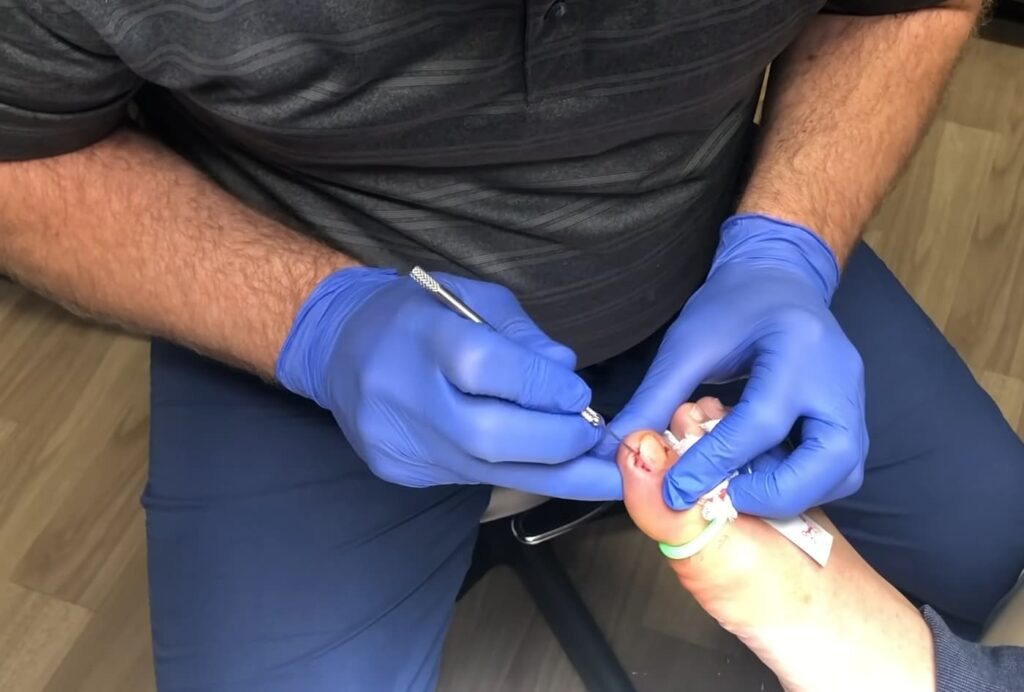
If home remedies are not effective, it’s advisable to seek a podiatrist’s expertise. Professional evaluation and personalized treatment strategies are critical for effective resolution. The primary goal of the initial appointment is to alleviate discomfort and treat any present infection or inflammation. In instances where the ingrown toenail is not infected, pain-free non-surgical trimming of the offending nail edge can be performed, with subsequent appointments to monitor healing and avert recurrence.
In cases where the condition is advanced or frequently recurring, more permanent solutions may be proposed. This includes surgical procedures carried out under local anesthesia to rectify the nail’s growth and prevent future problems.
| Procedure | Description |
|---|---|
| Partial Nail Avulsion (PNA) with Matrix Sterilization | This common, minimally invasive procedure involves removing the nail edge and applying a chemical (Phenol) to prevent regrowth. |
| Total Nail Avulsion (TNA) with Matrix Sterilization | In select cases, the entire nail may be removed and the nail matrix sterilized. |
| Wedge Resection | A more invasive option that involves removing a part of the nail matrix, recommended in specific situations and performed by senior practitioners. |
With a success rate of 97% for phenol-treated nails, these procedures are designed to be painless and have minimal recovery time, allowing most patients to return to their daily activities quickly, wearing open-toed footwear for comfort.
Addressing ingrown toenails promptly and effectively is key to preventing complications and ensuring the health and comfort of your feet.
Reducing Ingrown Toenail Risk: Effective Strategies
Ingrown toenails, characterized by their discomfort and potential for pain, necessitate proactive measures for their prevention. While individual anatomical variations in nail structure and uncontrollable external factors may contribute to the incidence of this condition, it is not entirely unavoidable.
Adopting certain practices can significantly reduce the likelihood of experiencing ingrown toenails. Here are some strategies:
- Trimming nails correctly is crucial; they should be cut straight across, avoiding rounding the corners, to prevent the nail from growing into the surrounding skin. Additionally, smoothing the nails’ edges with a file can further minimize the risk;
- Choosing the right footwear is another essential preventive measure. Shoes should provide sufficient space for the toes, ideally leaving a thumb’s width of space between the toes and the shoe’s front. Overly tight footwear can exacerbate the risk by putting undue pressure on the toes;
- Opting for open-toe or well-ventilated shoes can be beneficial, especially for individuals prone to perspiration, as it helps keep the feet dry and reduces the chances of nail-related issues.
By incorporating these recommendations into daily routines, individuals can effectively mitigate the risk of developing ingrown toenails, leading to healthier and more comfortable feet.
Conclusion
Ingrown toenails, although a common condition, can lead to significant discomfort and potential complications if not treated timely and correctly. Understanding the causes, recognizing the symptoms, and seeking appropriate treatment can aid in managing this condition effectively. While preventative measures can help mitigate some risk, timely professional help is essential in severe and persistent cases. With the right care and attention, you can keep your feet happy and healthy.
FAQs
Post-surgery recovery varies by individual and occupation. Typically, those with desk-bound roles can return to work the following day. It’s advisable to wear shoes that don’t constrict your feet, such as open-toed shoes or flip-flops, for a short period post-surgery.
To prevent ingrown toenails, it’s best to trim nails straight across and smooth the edges with a file. This avoids leaving any sharp corners that could press into the skin and cause discomfort.
Antibiotics can help manage any infection associated with an ingrown toenail but are not a cure for the nail’s improper growth. Consult with a specialist for proper treatment of the nail itself.
Yes, even infants can develop ingrown toenails. To avoid complications, gently file the edges to prevent them from digging into the skin. If signs of infection appear, such as redness, swelling, or discharge, try home remedies like soaking the affected foot in a warm saline solution. If there’s no improvement within 24-48 hours or symptoms worsen, please see a podiatrist or physician.
